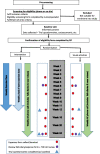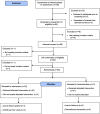Feasibility of trial procedures for a randomised controlled trial of a community based group exercise intervention for falls prevention for visually impaired older people: the VIOLET study
- PMID: 30541483
- PMCID: PMC6292024
- DOI: 10.1186/s12877-018-0998-6
Feasibility of trial procedures for a randomised controlled trial of a community based group exercise intervention for falls prevention for visually impaired older people: the VIOLET study
Abstract
Background: Visually impaired older people (VIOP) have a higher risk of falling than their sighted peers, and are likely to avoid physical activity. The aim was to adapt the existing Falls Management Exercise (FaME) programme for VIOP, delivered in the community, and to investigate the feasibility of conducting a definitive randomised controlled trial (RCT) of this adapted intervention.
Methods: Two-centre randomised mixed methods pilot trial and economic evaluation of the adapted group-based FaME programme for VIOP versus usual care. A one hour exercise programme ran weekly over 12 weeks at the study sites (Newcastle and Glasgow), delivered by third sector (voluntary and community) organisations. Participants were advised to exercise at home for an additional two hours over the week. Those randomised to the usual activities group received no intervention. Outcome measures were completed at baseline, 12 and 24 weeks. The potential primary outcome was the Short Form Falls Efficacy Scale - International (SFES-I). Participants' adherence was assessed by reviewing attendance records and self-reported compliance to the home exercises. Adherence with the course content (fidelity) by instructors was assessed by a researcher. Adverse events were collected in a weekly phone call.
Results: Eighteen participants, drawn from community-living VIOP were screened; 68 met the inclusion criteria; 64 participants were randomised with 33 allocated to the intervention and 31 to the usual activities arm. 94% of participants provided data at the 12 week visit and 92% at 24 weeks. Adherence was high. The intervention was found to be safe with 76% attending nine or more classes. Median time for home exercise was 50 min per week. There was little or no evidence that fear of falling, balance and falls risk, physical activity, emotional, attitudinal or quality of life outcomes differed between trial arms at follow-up.
Conclusions: The intervention, FaME, was implemented successfully for VIOP and all progression criteria for a main trial were met. The lack of difference between groups on fear of falling was unsurprising given it was a pilot study but there may have been other contributory factors including suboptimal exercise dose and apparent low risk of falls in participants. These issues need addressing for a future trial.
Trial registration: Current Controlled Trials ISRCTN ID: 16949845 Registered: 21 May 2015.
Keywords: Exercise; Falls management; Feasibility clinical trial; Older people; Visual impairment.
Conflict of interest statement
Consent for publication
Not Applicable.
Competing interests
Dawn Skelton (DS) is a Director of Later Life Training Ltd., a company that runs as a not for profit organisation, delivering FaME (PSI) training to health and fitness professionals across the UK.
Publisher’s Note
Springer Nature remains neutral with regard to jurisdictional claims in published maps and institutional affiliations.
Figures
References
-
- Painter J, Elliott S, Hudson S. Falls in community-dwelling adults aged 50 years and older: prevalence and contributing facotrs. J Allied Health. 2009;38:201–207. - PubMed
-
- Panel on Prevention of Falls in Older Persons American Geriatrics Society, British geriatrics society. Summary of the updated American Geriatircs society/British geriatrics society clinical practice guideline for prevention of falls in older persons. Journal of American Geriatric Society. 2011;59:148–157. doi: 10.1111/j.1532-5415.2010.03234.x. - DOI - PubMed
-
- Parry S, Bamford C, Deary V, Finch T, Gray J, MacDonald C, et al. Cognitive-behavioural therapy-based intervention to reduce fear of falling in older people: therapy development and randomised controlled trial - the strategies for increasing Independence, confidence and energy (STRIDE) study. Health Technol Assess. 2016:56. - PMC - PubMed
Publication types
MeSH terms
Associated data
Grants and funding
LinkOut - more resources
Full Text Sources
Medical
Miscellaneous



